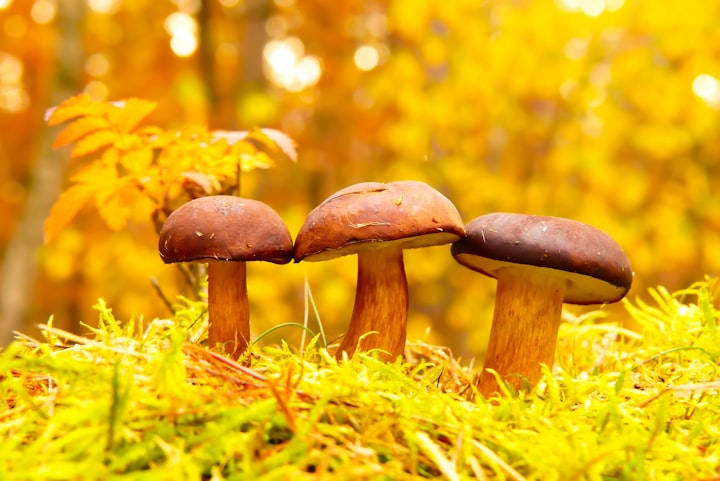Seven of the Deadliest Mushrooms on Earth
"Delving into Deadly Fungi: Seven of Earth's Most Lethal Mushrooms"

Even while only a small percentage of the 70–80 species of poisonous mushrooms are truly lethal when consumed, many of these deadly fungus are particularly dangerous since they uncannily resemble edible species. Continue reading to find out more about these frightfully deadly mushrooms.
Death Cap (Amanita phalloides)
The death cap, which resembles edible straw mushrooms and caesar's mushrooms and is thought to be the deadliest mushroom of all, is found all over Europe. Its heat-stable amatoxins swiftly destroy bodily cells by withstanding cooking temperatures. Rapid fluid loss from the tissues and extreme thirst are brought on by severe abdominal pain, vomiting, and bloody diarrhea that occur six to twelve hours after ingestion. Soon after, there are indicators of significant liver, renal, and central nervous system involvement, such as a drop in urine production and a drop in blood sugar. In about half of the cases, this illness results in a coma and death. Notable deaths include the accidental death by poisoning of Pope Clement VII in 1534 and the possible death of Roman Emperor Claudius in 54 CE.
Conocybe filaris
The very innocuous-looking Conocybe filaris grass mushroom is particularly prevalent in the Pacific Northwest. C. filaris has mycotoxins similar to those of the death cap mushroom, which means that consuming it could be lethal. When gastrointestinal symptoms appear, it's usually 6 to 24 hours after the mushrooms are taken. This might cause early misdiagnosis of stomach flu or food poisoning. The patient may seem to be on the mend, but then experience a potentially fatal recurrence of the gastrointestinal distress along with renal and liver failure.]]
Webcaps (Cortinarius species)
The look of the two webcap species—the fool's webcap (Cortinarius orellanus) and the deadly webcap (Cortinarius rubellus)—as well as several edible variations is very similar. The toxin orellanin found in these mushrooms first mimics the symptoms of the common flu. Because of orellanin's deceptively lengthy latency period, which can range from two days to three weeks, misdiagnosis is frequently the result. If treatment is not received, the poison eventually results in renal failure and death. Four of the relatives of English novelist Nicholas Evans were admitted to the hospital in 2008 after he unintentionally gathered and served webcap mushrooms to them. The poisoning needed kidney transplants for him, his wife, and his brother-in-law.
Autumn Skullcap (Galerina marginata)
Galerina marginata is a common wood-rotting mushroom with gills that is found throughout the Northern Hemisphere and portions of Australia. It shares amatoxins with death cap mushrooms. If ingestion is not handled, it can be fatal and induce vomiting, diarrhea, hypothermia, and liver damage. Although it bears little resemblance to edible species, collectors have been blamed for multiple poisonings and fatalities when they mistake fall skullcap for the hallucinogenic Psilocybe mushrooms.
Destroying Angels (Amanita species)
In reality, there are multiple varieties of all-white Amanita mushrooms that resemble the destroying angels. These highly deadly mushrooms have been inadvertently harvested on multiple occasions. They resemble edible button mushrooms and meadow mushrooms in appearance. Amanita bisporigera, one of these species, is thought to be the most dangerous mushroom found in North America. The illness typically results in mortality and manifests as vomiting, delirium, convulsions, diarrhea, liver, and kidney failure within five to twenty-four hours.
Podostroma cornu-damae
This uncommon fungus is indigenous to Asia and has killed several people in Korea and Japan. For individuals unfortunate enough to ingest them, the powerful toxins found in its red fruiting bodies, known as trichothecene mycotoxins, can result in multiple organ failure. Poisoning can cause low blood pressure, peeling skin, hair loss, stomach pain, liver necrosis, rapid kidney failure, and, if untreated, death.
Deadly Dapperling (Lepiota brunneoincarnata)
A poisonous mushroom with gills that is known to contain amatoxins is called a dapperling. Though poisonings are rare, the fungus, which is widely dispersed throughout Europe and portions of Asia, is generally harmless and has been mistaken for edible kinds. When accidentally consumed, the result is severe liver poisoning, which can be fatal if treatment is not received very after.





Comments
There are no comments for this story
Be the first to respond and start the conversation.